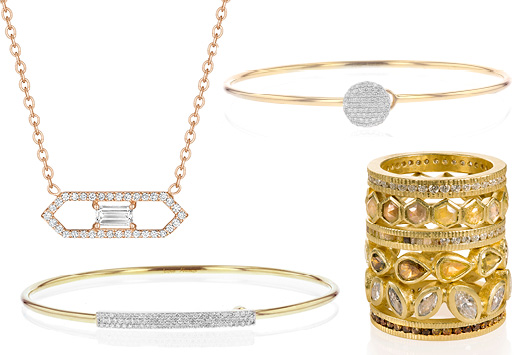
Four years ago, Dana Friedman gave her former jewelry store employer a shock with the method she used to sell a pricey diamond rivière necklace: She adorned it with small diamond-studded silver and gold enhancers to show a casual, edgy effect.
“‘How can you do that!?’” she exclaims in recollection, mimicking her old boss. Today, the owner of Petite G., a purveyor of fashion-forward fine jewels in Indianapolis, Indiana, responds: “Because you can, and you should; nobody wants to wear formal pieces anymore.”
The athleisure revolution
The rise in casual styles like delicate pendant necklaces and multiples of mix-and-match studs is partly attributable to the popularity of athleisure clothing, a blend of athletic wear and casual attire. Recent reports in
Forbes,
Business Insider and other publications reinforce the power of this sartorial movement: Athleisure has moved from a trend category to a niche one.
Naturally — and much to the chagrin of fine jewelers who love big, bold jewels — lighter-weight, more diminutive pieces best complement yoga pants and t-shirts. And though many high-end retailers bristle at the thought of a lower-ticket sale, the fact is that merchants do profit from sales of daintier, daily-wear treasures.
More bang for their buck
Expert purveyors of casual inventory say the slimmer styles already have better margins (especially in contrast to engagement rings) and are an easier sell, particularly to female self-purchasers. This group prefers items that are versatile, can be worn daily, and don’t need to be saved for a special occasion; these shoppers don’t want their dollars to collect dust.
“Women today want to know they can wear something a lot in different situations,” notes Melissa Quick of Steve Quick Jewelers in Chicago. “As soon as you have bigger diamonds involved, it’s easier to commoditize or price shop.”
There’s also a mind-set to promote: You are helping customers build collections, not just buy single pieces. Plus, casual jewels are affordable enough to give as gifts.
“The client who spends a couple of thousand dollars on one item will still spend the same [on smaller, stackable pieces], but they’ll get more than one piece,” observes Elizabeth Elliott of Moyer Fine Jewelers in Carmel, Indiana.
Image (clockwise): Penny Preville, necklace pennypreville.com; Phillips House, Love Always bracelet and Affair strap bracelet phillipshouse.com; Todd Reed, stacking bridal rings toddreed.comArticle from the Rapaport Magazine - March 2018. To subscribe click here.